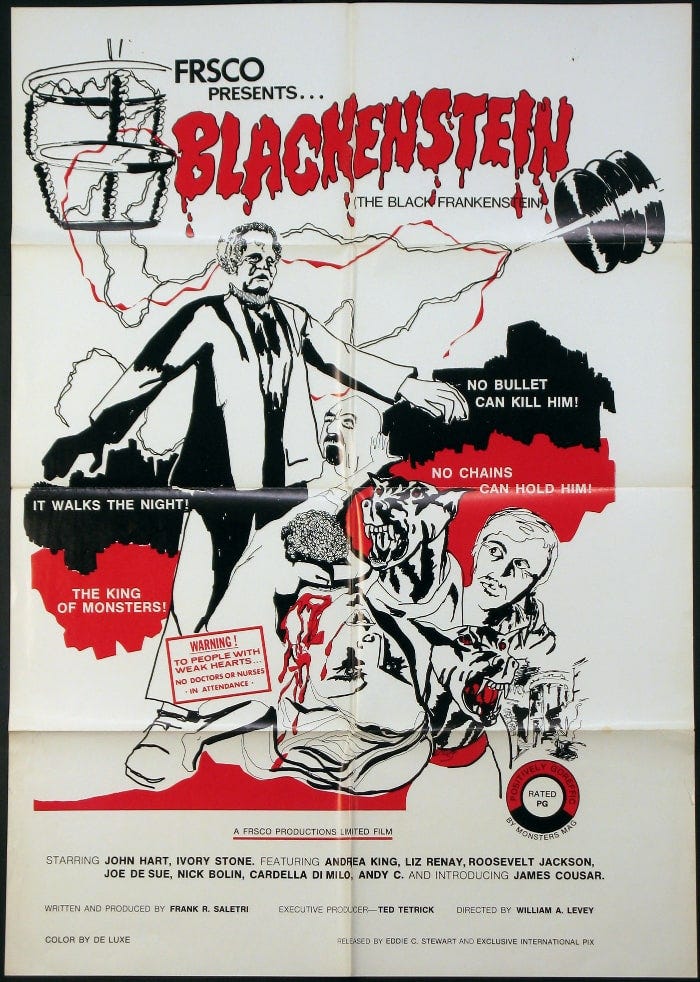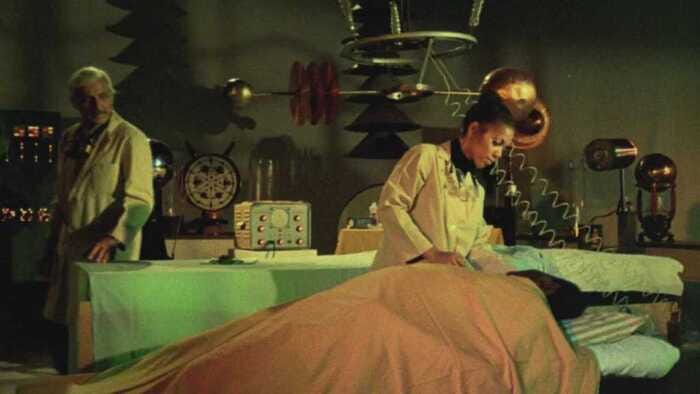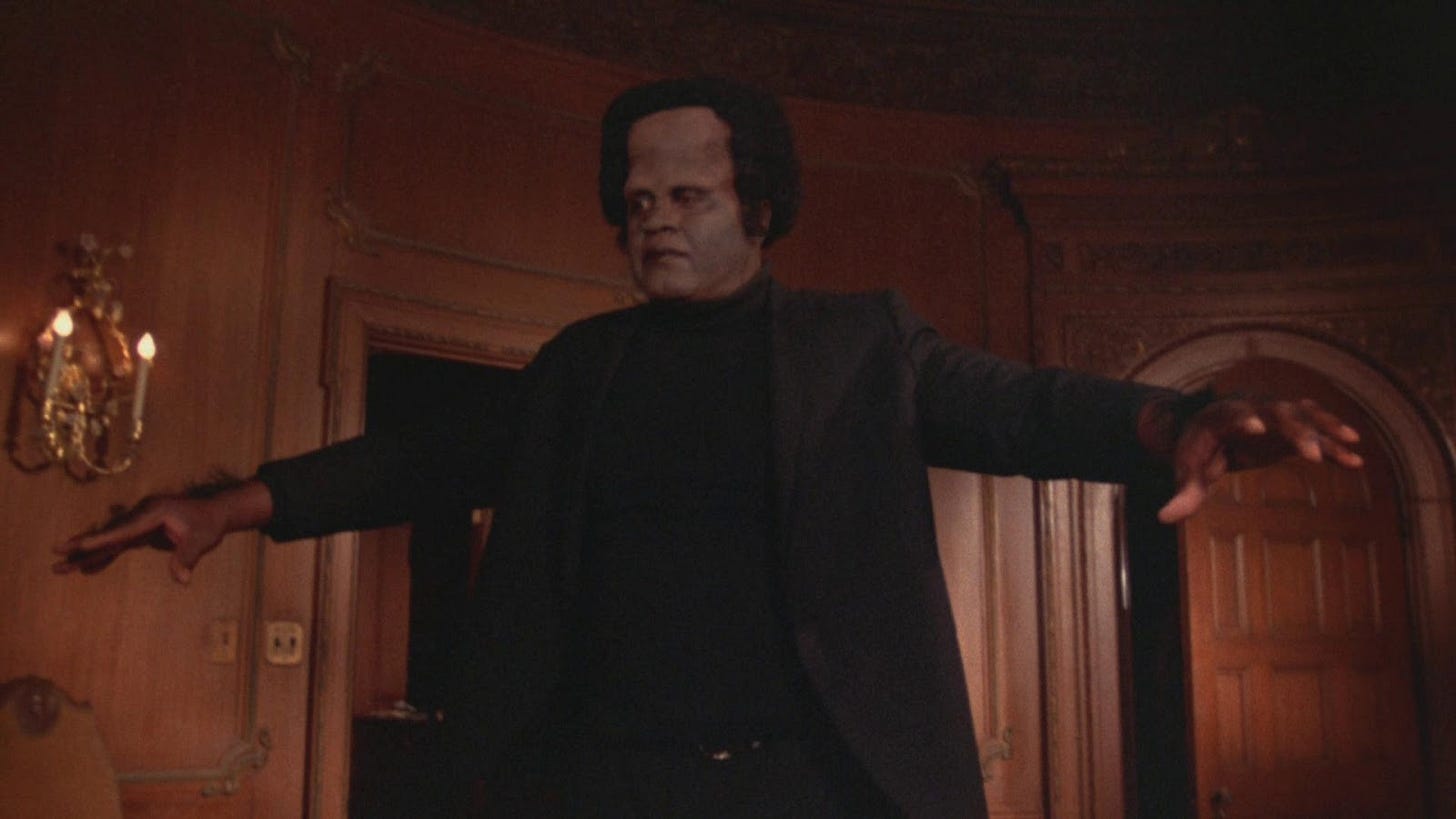Blaxploitation Education: Blackenstein
The full title is Blackenstein: The Black Frankenstein, for anybody who didn't quite understand what's going on here.
Blackenstein
Written by Frank R. Saletri
Directed by William A. Levey
1973
Some Blaxploitation movies spoke to people whose voices previously hadn’t been heard very much, dealing with concerns that affected Black audiences and gave them recognizable characters that they could relate to. And others tried to capitalize on the craze by cramming the word “black” into the title and plugging one or two Black actors into generic B-movie scripts. That’s what we get with Blackenstein, which seems to be something thrown together over the course of a weekend or so in order to put out something that sort of fit into the burgeoning genre.
A small budget and amateurish actors don’t have to spell doom for a movie, but they don’t exactly inspire much confidence, especially when it turns out that the script is pretty rudimentary as well, and the primary enjoyment will come from some monster mayhem with ridiculous makeup, lots of gore, and a little bit of gratuitous nudity. I’m always hopeful that some social commentary will sneak in to this sort of thing, but any that shows up here is completely accidental. That probably won’t stop me from trying to invent some subtext though, just so I have something to talk about.
So, if you’re going to make a “Black Frankenstein” movie and set it in the modern day, what is it going to be about? For these filmmakers, it’s little more than an excuse to have a scientist turn a Black guy into a monster and have him rampage around for a while before being killed. The monster here is a Vietnam veteran who had lost both arms and both legs to a land mine, but his girlfriend tries to give him a new lease on life by having her scientist mentor graft some new limbs on and give him some DNA injections. Even though the equipment in the laboratory where the work is being conducted screams “mad scientist,” she and everyone else seem surprised when the procedure actually turns him into a monster. In this sort of movie, you have to be prepared for that eventuality.
The woman is Dr. Winifred Walker (Ivory Stone), who has decided to get help for her boyfriend from an old teacher of hers, Dr. Stein (John Hart), whose first name and middle initial are presumably Frank N. Rather than seeming like a mad scientist, he has the air of a kindly Midwestern family practitioner, but apparently he won a Nobel prize because he “cracked the DNA code,” and that somehow translatates to transplanting limbs. She should have been worried that Stein operates out of a castle-like manor that’s perpetually shrouded in mist, but like most people in this movie (as well as those who made it), she doesn’t seem to think about things too hard.
Stein does have some other patients that may indicate his amazing medical skills though, including a lady who is in her 90s that he was able to de-age by several decades through his DNA formula, as well as a man named Bruno whose severed leg he reattached. However, some of the treatment went wrong for Bruno, since we see that his other leg has tiger stripes, which Stein says has to do with a primeval RNA mutation. But don’t worry about that, I’m sure it won’t come up later or anything.
Winifred’s boyfriend Eddie (Joe DeSue, who seems to have been cast primarily because he is a large man) is languishing in a veteran’s hospital, where he is mistreated by an orderly who yells at him about how this is all a waste of his tax dollars. He gets mad because he couldn’t join the army due to a heart condition, and he complains that Eddie was stupid because he didn’t have to go to Vietnam. This was well before the days of Fox News, but this guy seems like one of their faithful viewers who yells about the importance of patriotism and supporting the troops but does the opposite when confronted by one of those actual troops, and also apparently wasn’t aware that people who were drafted into the armed forces didn’t have much of a choice about whether they got to go to war.
After Winifred and Stein bring Eddie back to the mansion, they set about performing the transplant procedures. Where they get his replacement limbs is never explained, so maybe there’s some grave-robbing going on in addition to these ethically-dubious experiments. The procedure itself would seem like it would simply consist of attaching these limbs and providing injections of Stein’s magical DNA formula, but it also has to include all sorts of electrical equipment that features blinking lights, loud noises, and crackling lightning bolts. Maybe Stein just needs all of that to provide the necessary atmosphere for forbidden experimentation that violates the boundaries between life and death.
At first, Eddie seems to be responding nicely, but there has to be something that will make him turn monstrous. That comes in the form of Dr. Stein’s other assistant, Malcomb (Roosevelt Jackson), a Black man who mostly speaks in a monotone. While working alongside Winifred, he has fallen in love with her, but when he confesses his feelings, she shoots him down, insisting that she plans to marry Eddie once he fully recovers but reassuring Malcomb that they can still be friends. He responds by sneaking into the lab and switching out Eddie’s DNA formula with Bruno’s.
Before long, Eddie has developed a prominent brow ridge, and Dr. Stein says his brain tissue is in danger of dying. He and Winifred keep trying to come up with a treatment that will save him, but unbeknownst to them, Eddie has started getting up at night, sneaking out of the house, wandering around the neighborhood, and murdering random people. This quickly begins to beggar belief, not only due to the fact that he repeatedly leaves and re-enters the house without anybody noticing, but also because he should be covered with blood after ripping people’s arms off and tearing their guts out, so either he’s cleaning himself up or Stein and Winifried are too unobservant to notice all the gore.
There’s also some question about how intelligent Eddie/Blackenstein is at this point. For his first murder, he returns to the veteran’s hospital and kills the orderly that tormented him earlier, which means that there must be some direction to what he’s doing. But all of the other murders are just random people he happens across, so he’s also supposed to be completely mindless. But he’s also capable of finding his way home and tucking himself comfortably into bed when he’s done with his rampages, so maybe the mindlessness is all just an act. Or maybe the real answer is that I shouldn’t bother thinking about this for more than five seconds and just accept that the movie is about a monster killing people with little rhyme or reason.
Since everything about the movie indicates that the filmmakers didn’t put much thought into things, there’s no way any sort of subtext was intended. However, I can’t help but read into things, at least a little bit. Eddie’s plight seems reminiscent of the way Black people have been experimented on by unscrupulous scientists, such as in the infamous Tuskegee syphilis study or the experiments the “father of modern gynecology” performed on enslaved Black women. Some of Eddie’s attacks seem designed to evoke racist ideas of Black men preying on white women, such as when he kills a young woman walking alone through a park. And it’s also notable that Eddie is finally defeated when the police sic some dogs on him and they tear him apart.
However, all of that was surely accidental, or at least was included in the movie without much thought as to how it would appear. In actuality, the only memorable element of the movie that would be likely to speak to the Black experience would be a brief scene in a nightclub full of Black people where the emcee tells a dumb joke about a talking dog before introducing Cardella De Milo, who also sings the film’s surprisingly soulful theme song, “I Can’t Find No One to Love Me.” There’s at least a little bit of life in this movie, but it’s mostly incidental to a dumb plot and scenes of monstrous horror that are far too slow-moving. The whole thing is pretty bad, but the missed opportunity to say something (anything!) about the issues affecting what seemed to be its intended audience, even when the metaphors were right there for the taking, is what’s most egregious.
Blaxploitation Education index:
UpTight
Cotton Comes to Harlem
Watermelon Man
The Big Doll House
Shaft
Sweet Sweetback’s Baadasssss Song
Super Fly
Buck and the Preacher
Blacula
Cool Breeze
Melinda
Slaughter
Hammer
Trouble Man
Hit Man
Black Gunn
Bone
Top of the Heap
Across 110th Street
The Legend of N***** Charley
Don’t Play Us Cheap
Shaft’s Big Score!
Non-Blaxploitation: Sounder and Lady Sings the Blues
Trick Baby
The Harder They Come
Black Mama, White Mama
Black Caesar
The Mack
Book of Numbers
Charley One-Eye
Ganja & Hess
Savage!
Coffy
Shaft in Africa
Super Fly T.N.T.
Scream Blacula Scream
Cleopatra Jones
Terminal Island
Gordon’s War
Slaughter’s Big Rip-Off!
Detroit 9000
Hit!
The Spook Who Sat by the Door
The Slams
Five on the Black Hand Side
The Black 6
Hell Up in Harlem
I Escaped From Devil’s Island







Fun movie lol
By the late 1940s, the once impressive Universal horror films had become marred by constant regular resurrections of casts and scripts. This film resembles that more than anything else.
It reminds me of a couple of occasions where this was more successfully played for laughs. "The Simpsons" spoofed this whole mini-canon well by having Blacula and Blackenstein kill a "honky" who insulted them by wanting to turn their roller skating rink into a hockey rink. ("You mean HONKY rink!"). And then suggested that there was an option for a story the earlier filmmakers hadn't considered- "The Blunchback Of Bloter Blame"! (Black Quasimodo would have been the more likely title, though.)
These kinds of films were also spoofed very well several times on the sketch comedy show "Mad TV" when Keegan Michael Key and Jordan Peele were cast members. Naturally, there was a Black Frankenstein involved but they gave him a better name- "Funkenstein"!